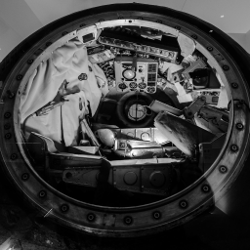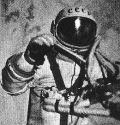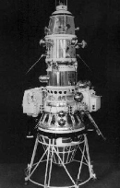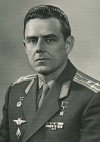The Soviet Union benefited from the capture of German scientists and technology near the end of World War II. Adding to work already done by rocketry pioneer Sergei Korolev, the Soviet government embarked on a space program in the 1950s.
One of the first major developments in this space initiative was the launching of the world's first intercontinental ballistic missile, the R7 Semyorka. This missile was modeled on Nazi Germany's vaunted V-2. Korolev oversaw its development and launch, which took place in August 1957. Two months later, the Soviet Union used an R7 to launch the world's first artificial satellite, Sputnik.
Not two months later, the Soviets were back with another first, an animal launched into space. The famous Laika was aboard Sputnik 2, which launched on Nov. 3, 1957. Sputnik was not designed to return safely from Earth orbit, and so Laika died. Scientists think that she died during the flight. In any event, Sputnik 2 burned up on re-entry.
Two subsequent dogs to go into space, Belka and Strelka, had better luck because their spacecraft had been designed for re-entry. The dogs, launched in 1960, survived, along with the other animal passengers, a rabbit, dozens of mice and rats, and some fruit flies.
In between launches of animals, the Soviet space program embarked on a plan for manned space flight. Those dreams were realized on April 12, 1961, when Yuri Gagarin spent 108 minutes in space, completing an orbit of Earth and returning safely.
Gagarin flew aboard the spacecraft Vostok 1. Other Vostok craft followed. Not long after Gagarin touched down, his backup for the first-man-in-space mission, Gherman Titov, became the first person to sleep in space, on August 6, aboard Vostok 2; he completed 17 orbits in all. Vostok 3, with Andrian Nikolavey aboard, and Vostok 4, with Pavel Popovich aboard, completed the first dual manned spaceflight in 1962. Vostok 5, with Valery Bykovsky aboard, flew close to Vostok 6 in 1963, and the two established a radio link. Vostok 6 was notable for its occupant, Valentina Tereshkova, the first woman in space.

The October 1964 launch of Voskhod 1 was notable for a number of firsts. The seventh manned mission of the Soviet space program, Voskhod 1 was the first to have more than one cosmonaut aboard. It had been designed to carry two, but government officials had insisted on squeezing three people inside and so command pilot Vladimir Komarov, engineer Konstantin Feoktistov, and doctor Boris Yegorov enjoyed cramped quarters. (They had to forgo spacesuits because there wasn't room in the capsule and because the weight would have too much. They set an altitude record of 209 miles.)

In March 1965, Alexei Leonov, aboard Voskhov 2 (one of two cosmonauts, the other being Pavel Belyayev), performed the first spacewalk. Wearing a special suit, he was outside for all of 12 minutes.
As did the U.S., the Soviet space program focused on unmanned probes as well. Luna 1 in 1959 was the first man-made object to go anywhere near the Moon. In the same year, Luna 2 became the first such object to land on the Moon and Luna 3 beamed back images of the far side of the Moon.

Not content with exploring just the Moon, Soviet scientists directed probes to Venus (Venera 1 in 1961 and Venera 3 in 1965, Venera 7 in 1970, Venera 9 in 1975), Mars (Mars 1 in 1962, Mars 2 and Mars 3 in 1971). In 1966, Luna 9 made a soft landing on the Moon and transmitted the first images from the lunar surface; later that year, Luna 10 became the first probe to establish lunar orbit.

Several of the missions sent into space by the Soviet space program suffered from close calls. Tragedy struck in 1967, when Soyuz 1 crashed, with Vladimir Komarov aboard; his parachute did not open properly. Development of the N1 rocket was problematic as well, and scientists in the Soviet Union lagged behind their counterparts in the United States as the 1960s wound down.
The U.S. became the first nation to land humans on the Moon and return them safely home, on July 20, 1969. The Soviet space program continued to focus on other endeavors. The Luna 16 mission was the first to extract soil samples from the Moon and return them to Earth, and it did that without human "hands." The first robotic space rover went to the Moon aboard Lunokhod 1.
As well, the Soviet Union launched the world's first space station, Salyut 1, in 1971 and the first permanently manned space station, Mir, in 1986.